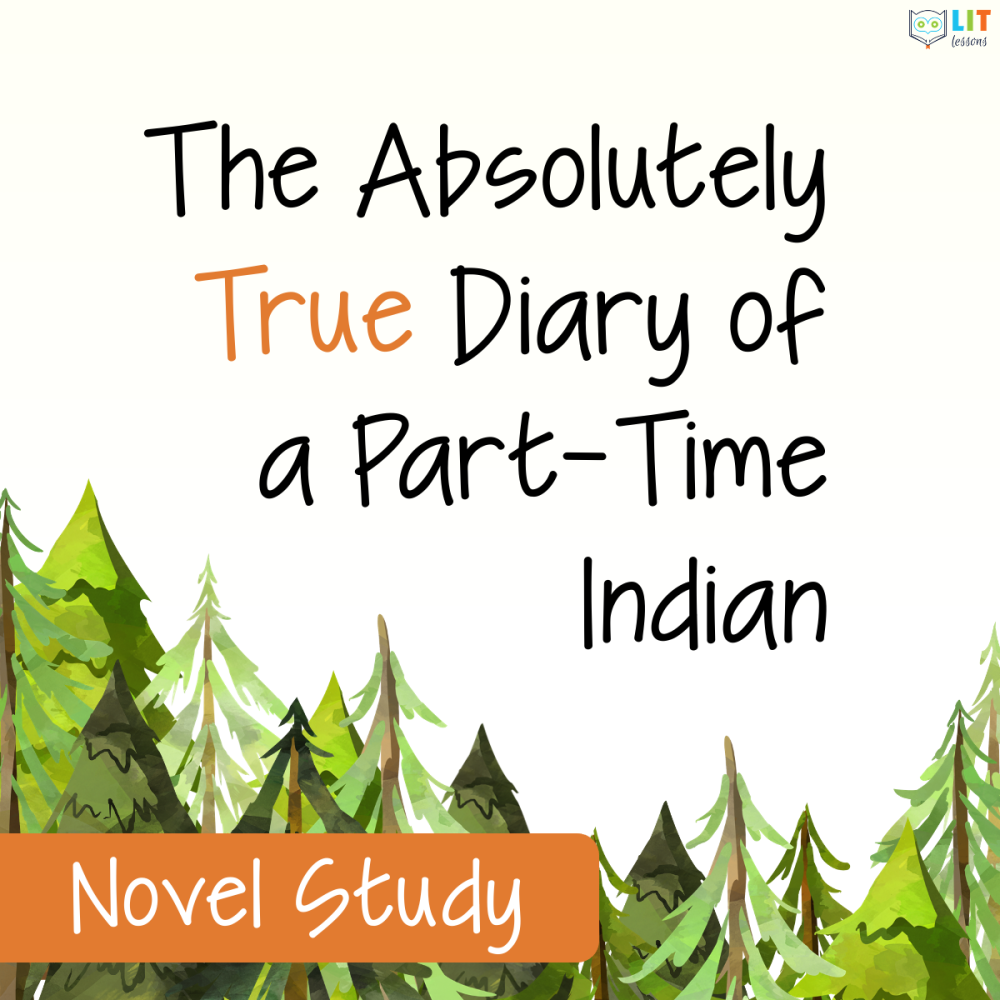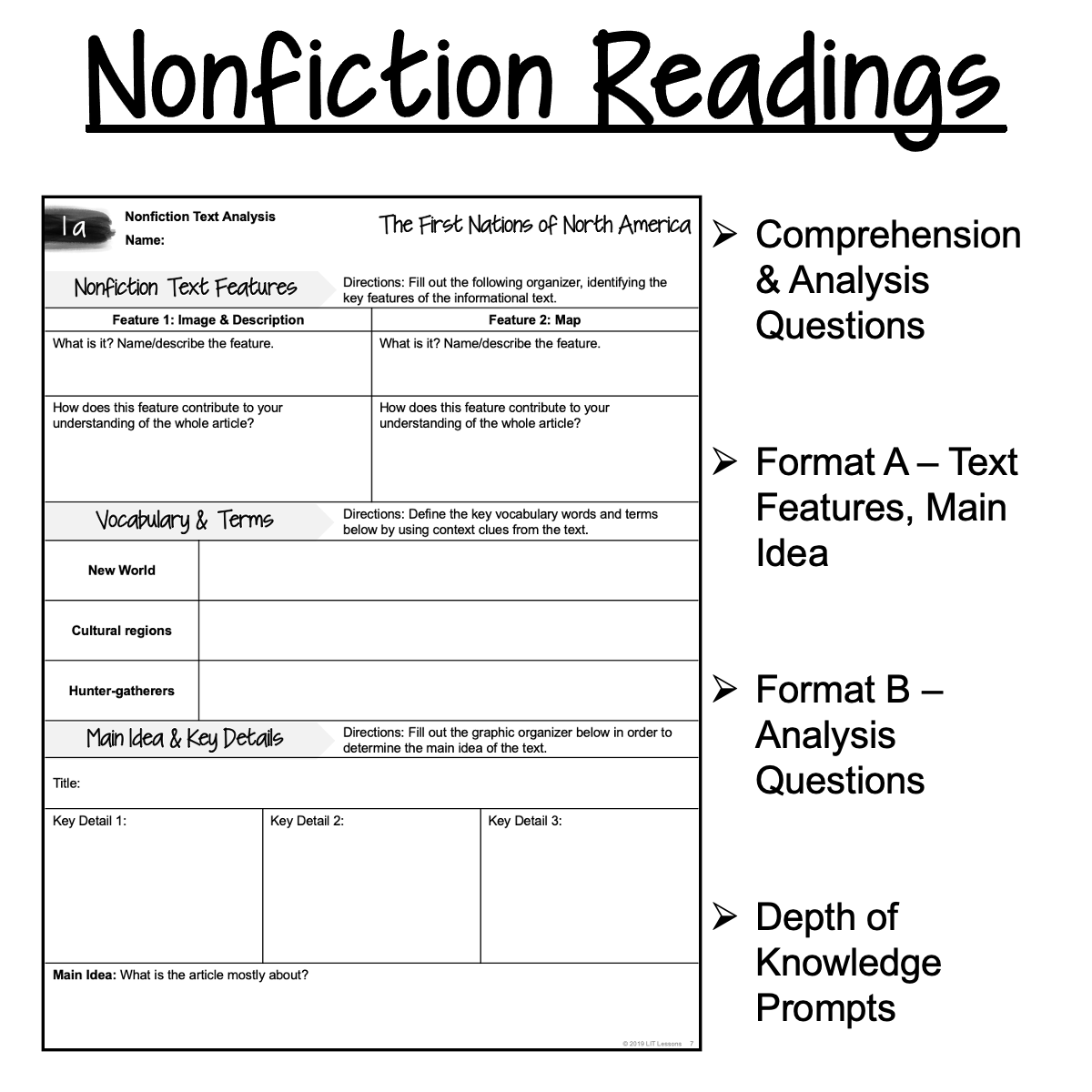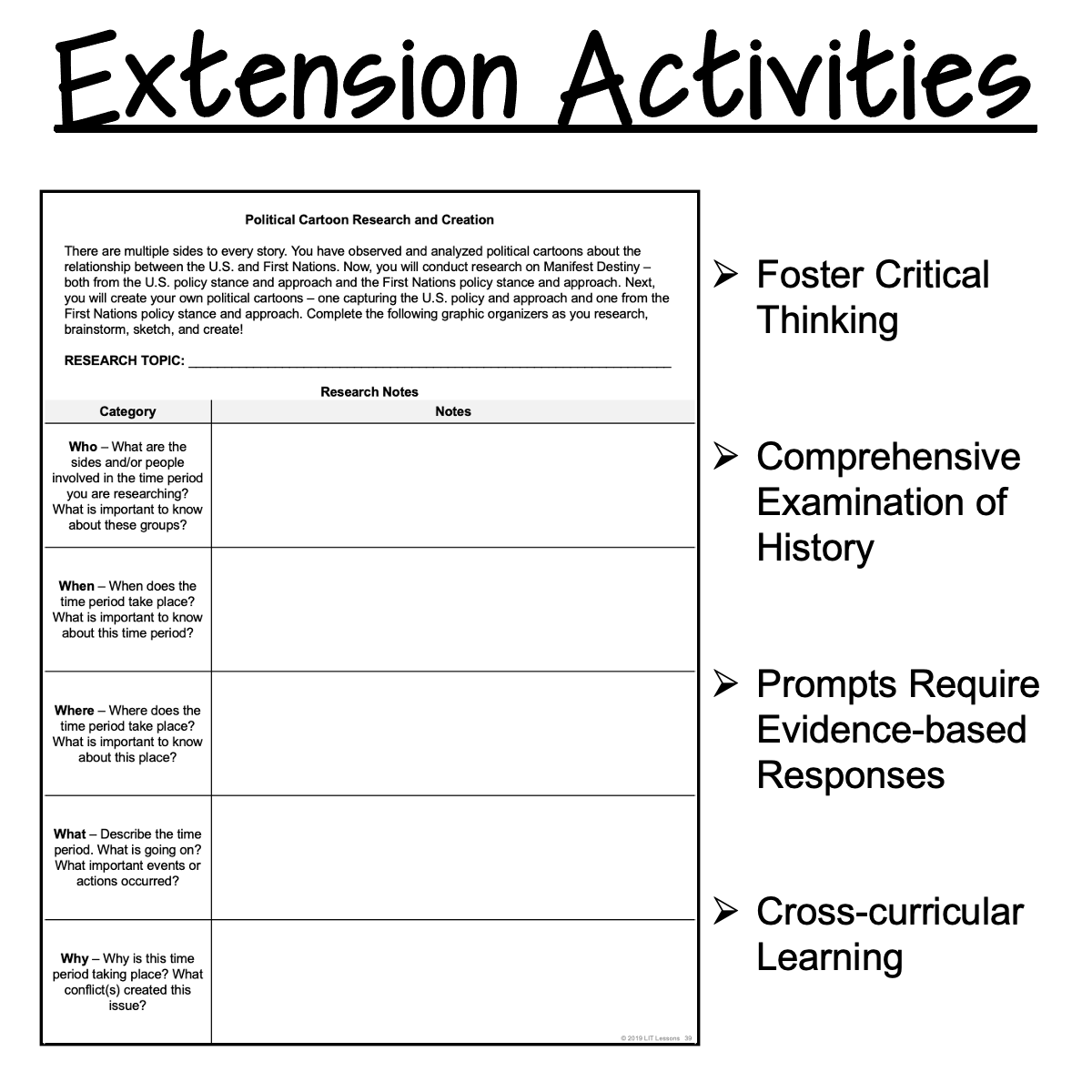The Absolutely True Diary of a Part-Time Indian Nonfiction Readings & Activities
You can only add to a wishlist if you have an account, please register now.
Create an Account$12
The Absolutely True Diary of a Part-Time Nonfiction Texts & Activities – Snapshot of Included Resources:
- 15 Informational Texts
- Variety of Text Features
- A & B Response Formats
- 10 Extension Activities
- Pair Texts with Nonfiction Readings
- Topics cover social, cultural, environmental, and political forces essential to understanding the history of First Nations
- Google Slides Links for Google Drive™
- Standards-Aligned Resources
- Answer Keys for Applicable Activities!
-
Citing textual evidence to support analysis of the text
-
Identifying and analyzing text features
-
Summarizing the main idea of a text with supporting details
-
Determining the meaning of words or phrases as used in the text
-
Determining author’s purpose and its effects
-
Identifying and analyzing arguments and specific claims in a text
-
Identifying and analyzing text structure and its effects
-
Identifying and analyzing cause and effect
-
Addressing Offensive Language: Offensive words for First Nations peoples can be found in The Absolutely True Diary of a Part-Time Indian and throughout documents created in relation to First Nations issues. It is critical students understand that some of these words are offensive and should not be used. This activity will help them understand the terms’ gravity and help prepare them to thoughtfully treat them when they are encountered. They will also assist the class in developing a respectful policy for when they encounter them in their work.
-
“America Before Columbus” Documentary: In the documentary viewing, students will learn more about the Americas prior to the arrival of the Europeans. The episode also contains rich information about other aspects of exploration and colonization. In doing so, it gives a broader framing of global events and historical context of that time period. *Documentary not included in this resource. Requires Internet access.*
-
Primary Source Analysis – Treaty of Canadaigua: For this extension activity, students will engage in a close reading of the Treaty of Canadaigua. Students will analyze language to discern meaning, intent, and the values being conveyed as they consider whether government action reflects stated ideals. They will also think critically about what the treaty, as a historical artifact, reveals about interactions between the First Nations and the United States government.
-
Primary Source Analysis – Indian Removal Act of 1830: For this extension activity, students will engage in a close reading of the Indian Removal Act of 1830. Students will analyze language to discern meaning, intent, and the values being conveyed. They will also think critically about what the law, as a historical artifact, reveals about interactions between the First Nations and the United States government.
-
Manifest Destiny and Political Cartoons: In this activity, students will analyze two political cartoons related to Manifest Destiny and American expansionism. Then, they will research about Manifest Destiny (optional), allowing them to examine the historical tensions in the region.
-
Image Analysis – Westward Expansion Changes the Landscape: Students will study four images that capture some of the story about the bison’s near extinction. As they examine the images, students will think critically about the animal’s demise, humans’ relationship with the environment, and what the bison’s story can reveal about how society’s attitudes toward it and the environment have evolved.
-
Historical Markers & Honoring the Past: Students will analyze the narrative of historical markers, examining an existing one to identify bias and incomplete portrayals. In doing so, they will think critically about history’s presentation. Next, through their own research and writing, they will create a more inclusive narrative as they revise the story of their chosen marker to draft a more comprehensive portrayal of the history it honors. *Requires Internet access.*
-
Primary Source Analysis – Carlisle Indian School Investigation & Report: For this primary source analysis, students will take part in a close reading of a congressional investigation into the Carlisle Indian School in 1914. Students will analyze its contents to develop a better understanding of the boarding school system, its treatment of First Nations students, and the harm it inflicted upon them.
-
Primary Source Analysis: An Apology to All Native Peoples: For this extension activity, students will engage in a close reading of a draft of the Apology to All Native Peoples and its final version. Students will analyze language to discern meaning, intent, and the values being conveyed. They will also think critically about what the resolution, as a historical artifact, reveals about interactions between the First Nations and the United States government.
-
TED Talk: The Standing Rock Resistance and Our Fight for Indigenous Rights: In the TED Talk viewing, students will learn more about Tara Houska’s efforts to fight for indigenous people’s rights. The episode contains rich information about the contemporary issues First Nations face today. It will also move students to reflect on the relationship between First Nations and the United States throughout history and into the present day. *Requires Internet access.*
- ZIP file (PDFs and Word Docs for Digital Links)
- Non-Editable
- 45.1 MB
- 208 Pages
- Links for Student Pages in Google Slides™
- This downloadable resource supplies one single-teacher license for use in your classroom.
- Photocopying of this product is allowed only for the classroom use of the purchaser.
- Replication of this product, in whole or in part, for commercial sale or broader distribution is strictly prohibited.
- This product also may NOT be shared electronically, digitally, or otherwise in a manner that violates the Terms of Use detailed by LIT Lessons.
- For explicit information on permissions, please see the Terms of Use document included with this resource. Thank you for your cooperation and understanding.
The Absolutely True Diary of a Part-Time Nonfiction Texts & Activities – Snapshot of Included Resources:
- 15 Informational Texts
- Variety of Text Features
- A & B Response Formats
- 10 Extension Activities
- Pair Texts with Nonfiction Readings
- Topics cover social, cultural, environmental, and political forces essential to understanding the history of First Nations
- Google Slides Links for Google Drive™
- Standards-Aligned Resources
- Answer Keys for Applicable Activities!
-
Citing textual evidence to support analysis of the text
-
Identifying and analyzing text features
-
Summarizing the main idea of a text with supporting details
-
Determining the meaning of words or phrases as used in the text
-
Determining author’s purpose and its effects
-
Identifying and analyzing arguments and specific claims in a text
-
Identifying and analyzing text structure and its effects
-
Identifying and analyzing cause and effect
-
Addressing Offensive Language: Offensive words for First Nations peoples can be found in The Absolutely True Diary of a Part-Time Indian and throughout documents created in relation to First Nations issues. It is critical students understand that some of these words are offensive and should not be used. This activity will help them understand the terms’ gravity and help prepare them to thoughtfully treat them when they are encountered. They will also assist the class in developing a respectful policy for when they encounter them in their work.
-
“America Before Columbus” Documentary: In the documentary viewing, students will learn more about the Americas prior to the arrival of the Europeans. The episode also contains rich information about other aspects of exploration and colonization. In doing so, it gives a broader framing of global events and historical context of that time period. *Documentary not included in this resource. Requires Internet access.*
-
Primary Source Analysis – Treaty of Canadaigua: For this extension activity, students will engage in a close reading of the Treaty of Canadaigua. Students will analyze language to discern meaning, intent, and the values being conveyed as they consider whether government action reflects stated ideals. They will also think critically about what the treaty, as a historical artifact, reveals about interactions between the First Nations and the United States government.
-
Primary Source Analysis – Indian Removal Act of 1830: For this extension activity, students will engage in a close reading of the Indian Removal Act of 1830. Students will analyze language to discern meaning, intent, and the values being conveyed. They will also think critically about what the law, as a historical artifact, reveals about interactions between the First Nations and the United States government.
-
Manifest Destiny and Political Cartoons: In this activity, students will analyze two political cartoons related to Manifest Destiny and American expansionism. Then, they will research about Manifest Destiny (optional), allowing them to examine the historical tensions in the region.
-
Image Analysis – Westward Expansion Changes the Landscape: Students will study four images that capture some of the story about the bison’s near extinction. As they examine the images, students will think critically about the animal’s demise, humans’ relationship with the environment, and what the bison’s story can reveal about how society’s attitudes toward it and the environment have evolved.
-
Historical Markers & Honoring the Past: Students will analyze the narrative of historical markers, examining an existing one to identify bias and incomplete portrayals. In doing so, they will think critically about history’s presentation. Next, through their own research and writing, they will create a more inclusive narrative as they revise the story of their chosen marker to draft a more comprehensive portrayal of the history it honors. *Requires Internet access.*
-
Primary Source Analysis – Carlisle Indian School Investigation & Report: For this primary source analysis, students will take part in a close reading of a congressional investigation into the Carlisle Indian School in 1914. Students will analyze its contents to develop a better understanding of the boarding school system, its treatment of First Nations students, and the harm it inflicted upon them.
-
Primary Source Analysis: An Apology to All Native Peoples: For this extension activity, students will engage in a close reading of a draft of the Apology to All Native Peoples and its final version. Students will analyze language to discern meaning, intent, and the values being conveyed. They will also think critically about what the resolution, as a historical artifact, reveals about interactions between the First Nations and the United States government.
-
TED Talk: The Standing Rock Resistance and Our Fight for Indigenous Rights: In the TED Talk viewing, students will learn more about Tara Houska’s efforts to fight for indigenous people’s rights. The episode contains rich information about the contemporary issues First Nations face today. It will also move students to reflect on the relationship between First Nations and the United States throughout history and into the present day. *Requires Internet access.*
- ZIP file (PDFs and Word Docs for Digital Links)
- Non-Editable
- 45.1 MB
- 208 Pages
- Links for Student Pages in Google Slides™
- This downloadable resource supplies one single-teacher license for use in your classroom.
- Photocopying of this product is allowed only for the classroom use of the purchaser.
- Replication of this product, in whole or in part, for commercial sale or broader distribution is strictly prohibited.
- This product also may NOT be shared electronically, digitally, or otherwise in a manner that violates the Terms of Use detailed by LIT Lessons.
- For explicit information on permissions, please see the Terms of Use document included with this resource. Thank you for your cooperation and understanding.



More The Absolutely True Diary of a Part-Time Indian Resources
The Absolutely True Diary of a Part-Time Indian Novel Study
The Absolutely True Diary of a Part-Time Indian Novel Study is a comprehensive set of standards-aligned instructional materials for teaching The Absolutely True Diary of a Part-Time Indian by Sherman Alexie. With over 100+ materials, students will deeply engage with the novel and develop their literacy skills. The close reading activities, literary analysis resources, nonfiction readings and activities, vocabulary, assessments, and final project all provide opportunities for your students to practice and apply what will be their growing understanding of the novel. They also provide numerous ways for you to DIFFERENTIATE learning for your students, allowing you to choose the assignments that best support your students’ learning while being conducive to any classroom model.
The Absolutely True Diary of a Part-Time Indian Comprehension & Literary Analysis Chapter Questions
The comprehension guide and literary analysis resources provide a framework for students to deeply engage with every chapter grouping of The Absolutely True Diary of a Part-Time Indian. The 32 assignments – 16 comprehension and 16 literary analysis – are designed to not only to have students practice essential literary skills but also demonstrate their comprehension of the text. In having students demonstrate their understanding of the novel across both dimensions, the resource allows for differentiation and flexible implementation.
The Absolutely True Diary of a Part-Time Indian Close Readings
The 16 close reading lessons explicitly focus on critical Common Core State Standards to develop students’ literary proficiency. Using The Absolutely True Diary of a Part-Time Indian as the foundational text for close reading, each lesson focuses on a particular skill, such as setting, conflict, tone, and plot, and provides students an opportunity to develop and demonstrate their ability to perform that skill. Each assignment also requires students to use textual evidence to support their claims. The resources could supply homework, facilitate guided reading groups, or stimulate whole class literacy discussions for each chapter grouping. You can choose the purpose that best suits your students and your classroom.
The Absolutely True Diary of a Part-Time Indian Assessments
The standards-aligned assessments will help you measure your students’ comprehension of The Absolutely True Diary of a Part-Time Indian and their ability to apply the literary skills taught throughout the unit. The materials include 16 reading checks, 2 novel quizzes, a differentiated final assessment, and essay prompts.
The Absolutely True Diary of a Part-Time Indian Vocabulary
The vocabulary resources will engage students in varied activities to expand their vocabulary. The resources include materials to help teach challenging vocabulary words in The Absolutely True Diary of a Part-Time Indian that will then build your students’ vocabulary. With 3 vocabulary lists of 10 words each and a crossword puzzle, practice assignment, and quiz for each set, the materials provide opportunities for differentiation to suit the needs of the classroom.

The Absolutely True Diary of a Part-Time Indian Novel Study
The Absolutely True Diary of a Part-Time Indian Novel Study is a comprehensive set of standards-aligned instructional materials for teaching The Absolutely True Diary of a Part-Time Indian by Sherman Alexie. With over 100+ materials, students will deeply engage with the novel and develop their literacy skills. The close reading activities, literary analysis resources, nonfiction readings and activities, vocabulary, assessments, and final project all provide opportunities for your students to practice and apply what will be their growing understanding of the novel. They also provide numerous ways for you to DIFFERENTIATE learning for your students, allowing you to choose the assignments that best support your students’ learning while being conducive to any classroom model.

The Absolutely True Diary of a Part-Time Indian Comprehension & Literary Analysis Chapter Questions
The comprehension guide and literary analysis resources provide a framework for students to deeply engage with every chapter grouping of The Absolutely True Diary of a Part-Time Indian. The 32 assignments – 16 comprehension and 16 literary analysis – are designed to not only to have students practice essential literary skills but also demonstrate their comprehension of the text. In having students demonstrate their understanding of the novel across both dimensions, the resource allows for differentiation and flexible implementation.

The Absolutely True Diary of a Part-Time Indian Close Readings
The 16 close reading lessons explicitly focus on critical Common Core State Standards to develop students’ literary proficiency. Using The Absolutely True Diary of a Part-Time Indian as the foundational text for close reading, each lesson focuses on a particular skill, such as setting, conflict, tone, and plot, and provides students an opportunity to develop and demonstrate their ability to perform that skill. Each assignment also requires students to use textual evidence to support their claims. The resources could supply homework, facilitate guided reading groups, or stimulate whole class literacy discussions for each chapter grouping. You can choose the purpose that best suits your students and your classroom.

The Absolutely True Diary of a Part-Time Indian Assessments
The standards-aligned assessments will help you measure your students’ comprehension of The Absolutely True Diary of a Part-Time Indian and their ability to apply the literary skills taught throughout the unit. The materials include 16 reading checks, 2 novel quizzes, a differentiated final assessment, and essay prompts.

The Absolutely True Diary of a Part-Time Indian Vocabulary
The vocabulary resources will engage students in varied activities to expand their vocabulary. The resources include materials to help teach challenging vocabulary words in The Absolutely True Diary of a Part-Time Indian that will then build your students’ vocabulary. With 3 vocabulary lists of 10 words each and a crossword puzzle, practice assignment, and quiz for each set, the materials provide opportunities for differentiation to suit the needs of the classroom.









